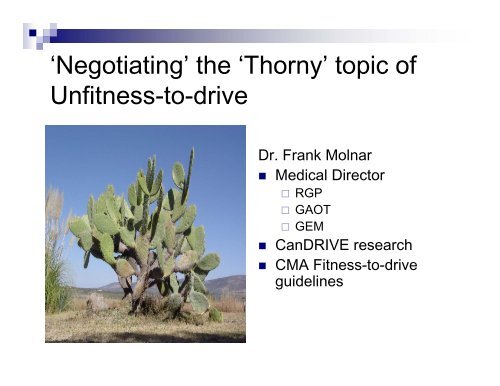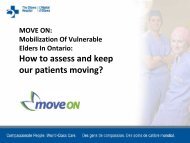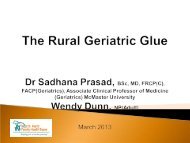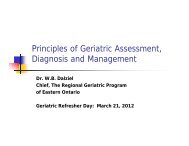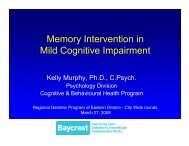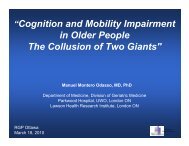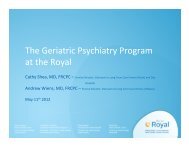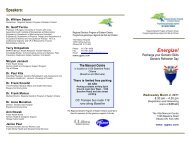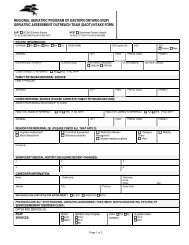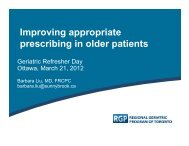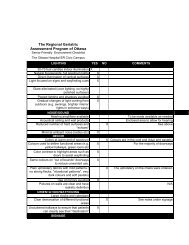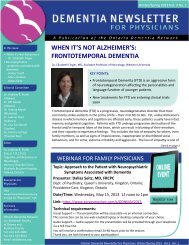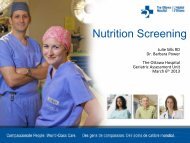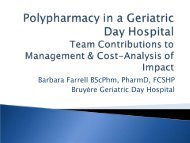Dr. Frank Molnar - Regional Geriatric Program of Eastern Ontario
Dr. Frank Molnar - Regional Geriatric Program of Eastern Ontario
Dr. Frank Molnar - Regional Geriatric Program of Eastern Ontario
You also want an ePaper? Increase the reach of your titles
YUMPU automatically turns print PDFs into web optimized ePapers that Google loves.
‘Negotiating’ the ‘Thorny’ topic <strong>of</strong><br />
Unfitness-to-drive<br />
<strong>Dr</strong>. <strong>Frank</strong> <strong>Molnar</strong><br />
• Medical Director<br />
RGP<br />
GAOT<br />
GEM<br />
• CanDRIVE research<br />
• CMA Fitness-to-drive<br />
guidelines
Disclosure<br />
• I do not have any perceived, potential or actual<br />
conflicts <strong>of</strong> interest relevant to driving – no<br />
Automotive Insurance Industry support<br />
• I do not have all the answers. Hopefully you will<br />
find some <strong>of</strong> the ideas presented to be useful<br />
and they will stimulate further discussion.
The Assessment <strong>of</strong> Fitness-to-drive
<strong>Geriatric</strong> Outpatient System<br />
Nested in Community Care System<br />
Local Health Integration Network (LHIN)<br />
<strong>Regional</strong> <strong>Geriatric</strong> Advisory Committee (RGAC)<br />
Information<br />
Champlain DH Leadership Committee<br />
Day<br />
Hospital<br />
Forum<br />
Day Hospitals /<br />
<strong>Geriatric</strong> Clinics<br />
Primary Care<br />
<strong>Geriatric</strong><br />
Assessment<br />
Outreach<br />
Teams (GAOT)<br />
<strong>Geriatric</strong><br />
Emergency<br />
Management<br />
(GEM)
Sometimes fitness-to-drive is less clear and<br />
more in-depth assessment is required<br />
• Alzheimer Knowledge Exchange<br />
<br />
<br />
Presentations<br />
www.drivinganddementia.org<br />
• CMA: Determining Medical Fitness to<br />
<strong>Dr</strong>ive: A Guide for Physicians.<br />
Canadian Medical Association <strong>Dr</strong>iver’s<br />
Guide 7 th edition.<br />
<br />
www.cma.ca/index.cfm/ci_id/18223/la_i<br />
d/1.htm<br />
• <strong>Dr</strong>iving and Dementia Tool Kit for<br />
Family Physicians (Dementia Network<br />
<strong>of</strong> Ottawa-Carleton)<br />
<br />
www.rgpeo.com or<br />
www.CanDRIVE.ca
www.cma.ca/index.cfm/ci_id/18223<br />
/la_id/1.htm
Let’s Focus on a high<br />
volume clinical<br />
condition<br />
Dementia and <strong>Dr</strong>iving
www.rgpeo.com
What happens AFTER the<br />
assessment?
Figure 1: Three-Tier Model <strong>of</strong> <strong>Dr</strong>iving Assessment in <strong>Ontario</strong><br />
Active Older <strong>Dr</strong>ivers<br />
(Tier 1a)<br />
MD screening<br />
& assessment<br />
(Tier 1b)<br />
informal screening<br />
during MTO 80+<br />
group education<br />
sessions<br />
Safe * Safety unclear Clearly unsafe<br />
(Tier 2)<br />
Cognitive tests<br />
(OT/Psychology)<br />
<strong>Dr</strong>iving Record<br />
or<br />
Police Reports<br />
Identifies drivers who<br />
may be at risk<br />
* Safety unclear<br />
(Tier 3a)<br />
OT on-road testing<br />
(specialized MTO<br />
certified testing centers)<br />
(Tier 3b)<br />
MTO on-road<br />
assessment<br />
Safe<br />
Unsafe – report to MTO<br />
MTO Reviewers and/or Committees<br />
Safe<br />
MTO (Ministry <strong>of</strong> Transportation <strong>of</strong> <strong>Ontario</strong><br />
OT (Occupational Therapy)<br />
* In some instances drivers whose safety is unclear are reported to the MTO<br />
Stop driving
<strong>Ontario</strong> Highway Traffic Act<br />
Report <strong>of</strong> medical practitioner<br />
• 203. (1) Every legally qualified medical practitioner shall<br />
report to the Registrar the name, address and clinical<br />
condition <strong>of</strong> every person sixteen years <strong>of</strong> age or over<br />
attending upon the medical practitioner for medical<br />
services who, in the opinion <strong>of</strong> the medical practitioner,<br />
is suffering from a condition that may make it dangerous<br />
for the person to operate a motor vehicle. R.S.O. 1990,<br />
c. H.8, s. 203 (1).<br />
• CMPA and CPSO advise not to report on a patient you<br />
have not seen as an MD could not say that they have<br />
‘attended upon” that patient,
Responsibility <strong>of</strong><br />
other pr<strong>of</strong>essions?<br />
• Optometrists<br />
• OTs<br />
• ???
Physician Assessment<br />
Patient not safe Uncertain safety Patient safe<br />
Discuss<br />
with patient<br />
and family<br />
Discuss<br />
with patient<br />
and family<br />
Provincial Ministry<br />
<strong>of</strong> Transport notification<br />
Patient notification<br />
(letter), copy<br />
for chart<br />
Patient wishes to continue<br />
driving → referral to<br />
specialist or specialized<br />
on-road driving evaluation<br />
or<br />
*At some<br />
time driving<br />
cessation will<br />
be necessary<br />
*Suggest driving<br />
training and<br />
self-limitation<br />
Patient decides<br />
to stop driving –<br />
Ministry <strong>of</strong><br />
Transport notification<br />
Book six- to<br />
nine-month follow-up<br />
to reassess driving safety
SAFE - How to Report<br />
• Mild dementia (no concerns re. <strong>Dr</strong>iving)<br />
“Patient has mild dementia with MMSE<br />
___, Trails B ___. I have not noted any<br />
evidence to suggest they are not fit to<br />
drive but feel they should be re-evaluated<br />
every 6 months.”<br />
• When should you send this?<br />
• What are the risks <strong>of</strong> sending this note?
Fitness to <strong>Dr</strong>ive Unclear -<br />
Further Assessment Required<br />
• Fitness to drive unclear or deficits<br />
may be temporary<br />
Testing borderline<br />
Resolving delirium<br />
• Notify jurisdictional authorities as per<br />
provincial reporting requirements<br />
• When should you send this?<br />
• What are the risks <strong>of</strong> sending this note?
UNCLEAR - How to Report<br />
• “Patient has a diagnosis <strong>of</strong> dementia and<br />
fitness-to-drive is unclear based on in<strong>of</strong>fice<br />
assessment. “<br />
• “There are no obvious reasons to mandate<br />
immediate license revocation but patient<br />
should have further evaluation (or should<br />
have on-road).”<br />
• When should you send this?<br />
• What are the risks <strong>of</strong> sending this note?
UNCLEAR - How to Report<br />
OR<br />
• “Patient should not drive until they are<br />
cleared by on-road testing.”<br />
If patient already has license revoked<br />
• “Please provide them with a one day<br />
license to permit on-road testing”
Specialized <strong>Dr</strong>iving Assessment<br />
• Cognitive and Visuo-spatial Screening tests<br />
(Neuropsychologist, OT)<br />
<br />
can rule out the more obviously impaired<br />
• <strong>Dr</strong>iving Simulator Evaluation<br />
<br />
<br />
not fully acceptable for ultimately determining<br />
fitness to drive<br />
can give insight to the evaluator for the on-road<br />
assessment<br />
• On-Road Assessment (OT/<strong>Dr</strong>iving Instructor)<br />
<br />
present Gold Standard
Outcomes <strong>of</strong> the<br />
Specialized Assessment<br />
• Fail<br />
• Pass<br />
Follow-up required (6 – 9 months for<br />
dementia)<br />
• Restricted license<br />
available in some provinces (not <strong>Ontario</strong>)<br />
• Q? is this safe or is it a political strategy to<br />
garner seniors’ votes?
What do you do if you find<br />
someone is unfit / unsafe to drive?
UNSAFE - How to Report<br />
Moderate to severe dementia<br />
• Canadian medical Association<br />
Guidelines<br />
• Moderate = 1 ADL or 2 iADLs impaired<br />
<br />
<br />
due to cognition)<br />
“Patient is not safe to drive due to the<br />
following findings:__________________”<br />
Just send findings with no opinion<br />
(opinion <strong>of</strong> fitness-to-drive not really<br />
required by Highway Traffic Code)
The MTO Medical condition<br />
report.<br />
• Fax to MTO (or mail if no fax)<br />
• Keep copy in chart with date on which it<br />
was sent<br />
• In urgent situations call the MTO Physician<br />
hot line using the number on the MTO<br />
report<br />
Long wait<br />
Will not give name<br />
• MTO will not tell you what their decision is
SAMPLE - WRITTEN STATEMENT TO THE<br />
PATIENT<br />
Date:<br />
Name:<br />
Address:<br />
Dear Mr (Mrs):<br />
I realize that this is a difficult recommendation for you, but based on the<br />
results <strong>of</strong> tests performed, I am recommending you do not drive.<br />
You have undergone assessment for memory/cognitive problems. It has<br />
been found by comprehensive assessment that you have<br />
________________________ dementia. The severity is<br />
_________________.<br />
Even with mild dementia, compared to people your age, you have an 8<br />
times risk <strong>of</strong> a car accident in the next year. Even with mild dementia,<br />
the risk <strong>of</strong> a serious car accident is 50% within 2 years <strong>of</strong> diagnosis.<br />
Additional factors in your health assessment that raise concerns about<br />
driving safety include:<br />
__________________________________________________________<br />
_________<br />
__________________________________________________________<br />
_________<br />
__________________________________________________________<br />
_________<br />
__________________________________________________________
Disclosure – unfit to drive<br />
Refer to <strong>Geriatric</strong>s and<br />
Aging article<br />
• What and How to tell<br />
patient when they are<br />
unsafe to drive<br />
Better communication<br />
decreases need to<br />
diffuse tense situations<br />
• Describe Challenging<br />
follow-ups
Patient Not Fit to <strong>Dr</strong>ive (permanent)<br />
• Meet with family first<br />
Do not let them establish a position that is contrary<br />
to yours (i.e. avoid creation <strong>of</strong> an adversarial<br />
relationship). Ask them to let you give them all the<br />
relevant information before they provide their<br />
opinion.<br />
Explain concern <strong>of</strong> safety for patient and others in a<br />
concrete and empathic fashion.<br />
Describe findings that make it clear that the patient is<br />
not safe to drive.<br />
Explain that the laws in your jurisdiction require you<br />
to report the patient to the Ministry <strong>of</strong> Transportation<br />
– that you have no choice and that to not report<br />
would be breaking the law.
Patient Not Fit to <strong>Dr</strong>ive<br />
• Meeting with family (cont.)<br />
<br />
<br />
Indicate that you are certain that they<br />
understand that the goal <strong>of</strong> the assessment is<br />
to prevent an accident that could injure the<br />
patient or others, therefore, we cannot wait for<br />
an accident to occur – that it would be too late,<br />
as many seniors do not survive or recover from<br />
MVCS. If others were injured, their parent<br />
would have to live with the guilt.<br />
Explain that since they are now aware <strong>of</strong> the<br />
risk, they too carry some responsibility.
Patient Not Fit to <strong>Dr</strong>ive<br />
• Meeting with family (cont.)<br />
Put the family in a supportive role<br />
• Thank the family (before they speak) for<br />
helping you with this difficult task. Indicate<br />
that while it is your legal responsibility to tell<br />
their parent, they can be the supportive party<br />
that emotionally helps their parent through a<br />
difficult time and helps them find<br />
transportation alternatives.<br />
– the good cop / bad cop approach
If the family doubt your findings<br />
• Explain the guidelines and laws<br />
• Explain the tests used<br />
• Discuss the findings (show them the test<br />
results)<br />
• If they are still dubious have them witness<br />
repeat performance on the most revealing<br />
test
Patient Not Fit to <strong>Dr</strong>ive<br />
• Meet with the patient<br />
<br />
<br />
Have family present but a priori ask them to<br />
assume the supportive (good cop) role and let<br />
you first disclose.<br />
Ask the patient to let you provide all the<br />
information first before they speak – avoid<br />
creating an adversarial position.<br />
• Explain that due to the clinical findings, the law<br />
mandates that they must cease driving and that while<br />
you dislike doing so, you must report them to the<br />
Ministry <strong>of</strong> Transportation – you cannot override or<br />
disobey the law.
Patient Not Fit to <strong>Dr</strong>ive<br />
• Meet with the patient (cont.)<br />
Give the patient a positive role<br />
• Recognize they have been a responsible<br />
driver and part <strong>of</strong> being a responsible driver is<br />
to hang up the keys BEFORE an MVC.<br />
• Acknowledge that you know they would never<br />
want to hurt others.<br />
Acknowledge that it is normal to be<br />
unhappy regarding this information
Patient Not Fit to <strong>Dr</strong>ive<br />
• Meet with the patient (cont.)<br />
Highlight positives<br />
• Taking a Taxis is cheaper than maintaining a car, if<br />
one drives less than 4000 km/year.<br />
• They took care <strong>of</strong> their children and now this is<br />
their children’s chance to pay them back – it is<br />
important for their children to feel they are helping.
Patient Not Fit to <strong>Dr</strong>ive<br />
• If patient continues to argue:<br />
Remain firm in instructions not to drive. Do not argue –<br />
<br />
<br />
they may have limited insight.<br />
Indicate the chart is a legal document that can be<br />
subpoenaed – the chart indicates that they and their<br />
family have been notified <strong>of</strong> their MVC risk. If they are<br />
involved in a crash, they may be legally liable and<br />
financially responsible.<br />
If they threaten a lawsuit, notify CPSO and CMPA, so they<br />
can advise and can open files.
Patient Not Fit to <strong>Dr</strong>ive<br />
• THEN ask the patient and family to<br />
comment (AFTER outlining lack <strong>of</strong><br />
choice due to Laws in <strong>Ontario</strong> and their<br />
respective positive roles).<br />
• Once again acknowledge that it is<br />
normal to feel bad about this<br />
development.
Patient Not Fit to <strong>Dr</strong>ive<br />
• Explore other transportation options.<br />
Family – share responsibility between several<br />
members. Family should ensure patient gets<br />
out <strong>of</strong> the house<br />
Taxi – can get private cell number <strong>of</strong> driver(s)<br />
that was / were particularly helpful and<br />
reliable. Plan a day ahead.<br />
Volunteer drivers<br />
ParaTranspo
Patient Not Fit to <strong>Dr</strong>ive<br />
• If patient is refusing to comply, then meet with family<br />
<br />
<br />
<br />
Encourage family to remove opportunity to drive if noncompliant<br />
(disable car, remove keys or car). Best to<br />
remove car as it is a constant reminder.<br />
If patient is in imminent danger to others, CALL Ministry <strong>of</strong><br />
Transportation physician line indicating need to remove<br />
license ASAP and fax in medical form.<br />
Call Police???
Patient Not Fit to <strong>Dr</strong>ive<br />
• After the disclosure meeting:<br />
<br />
<br />
<br />
<br />
Provide a written statement to the patient/family<br />
as to why the patient cannot drive, regarding<br />
your legal obligations, and intent to notify<br />
government authority.<br />
Continue to encourage family to remove<br />
opportunity to drive if non-compliant.<br />
Communicate in writing to your provincial<br />
Ministry <strong>of</strong> Transport. Call MD hotline if the<br />
situation is urgent.<br />
Document details <strong>of</strong> disclosure meeting in chart<br />
(date, people present, information disclosed)
UNSAFE TO DRIVE<br />
DISCLOSURE MEETING:<br />
When your patient is unfit to drive: 4 steps to driving cessation<br />
1. Meet with family first.<br />
Help them assume a positive and supportive role.<br />
Explain concretely and empathically your concern for the safety <strong>of</strong> the patient and others.<br />
Clearly outline your findings that the patient is not fit to drive, and explain that the law requires you to<br />
report the patient to the authorities.<br />
2. Meet with the patient.<br />
Having the family present can be helpful, but ask them to assume a supportive role.<br />
Give the patient a positive role by recognizing that he or she has been a responsible driver<br />
Acknowledge that it is normal to be unhappy upon learning that one’s driving privileges are being<br />
revoked.<br />
Sometimes it helps to give the patient a prescription in their name that says, “Do not drive.” Families<br />
who receive a copy may find this very helpful, too, for reminding the patient later about what you said<br />
If your patient argues with your position, remain firm and do not argue<br />
3. Talk about transportation options.<br />
Family members could share driving responsibilities<br />
Taxi rides can cost less than maintaining (including insurance, registration etc) a car if the patient<br />
drives
Dealing with complaints after you have<br />
complied with the law and reported an<br />
unsafe driver<br />
• How to deal with<br />
complaints to your<br />
administration<br />
• How to deal with your<br />
college (for MDs CPSO<br />
and CMPA)<br />
• What to say to patients<br />
and their families to<br />
prevent such complaints
Enough Talk – time for cases
Clinical Scenario - OCFP<br />
• You receive a report from a Sleep<br />
Specialist which reads ‘The findings <strong>of</strong> the<br />
sleep study indicate your patient may be<br />
unsafe to drive. I recommend you report<br />
them to the Ministry <strong>of</strong> Transportation”<br />
What do you do?
Clinical Scenario<br />
• You have found a patient unfit to drive<br />
and have informed them and their<br />
family. The patient says you are not<br />
permitted to send their medical<br />
information to the Ministry <strong>of</strong><br />
Transportation or they will sue you and<br />
call the college.<br />
<br />
What do you do?
Clinical Scenario<br />
• A patient is in your <strong>of</strong>fice who is<br />
clearly unfit to drive home. MMSE<br />
6/30. You tell them they should not<br />
drive home but they refuse to comply.<br />
You feel they are an imminent threat<br />
to public safety.<br />
<br />
What do you do?
<strong>Geriatric</strong> Outpatient System<br />
Nested in Community Care System<br />
Local Health Integration Network (LHIN)<br />
<strong>Regional</strong> <strong>Geriatric</strong> Advisory Committee (RGAC)<br />
Information<br />
Champlain DH Leadership Committee<br />
Day<br />
Hospital<br />
Forum<br />
Day Hospitals /<br />
<strong>Geriatric</strong> Clinics<br />
Primary Care<br />
<strong>Geriatric</strong><br />
Assessment<br />
Outreach<br />
Teams (GAOT)<br />
<strong>Geriatric</strong><br />
Emergency<br />
Management<br />
(GEM)
How should we handle this issue<br />
as a system <strong>of</strong> care?<br />
• A shared responsibility <strong>of</strong> various levels<br />
Family MD / referring specialist<br />
GAOT / GEM<br />
Day Hospital / Clinics<br />
• All previous MDs are responsible and have been<br />
sued after a car crash<br />
• Try to deal with the issue as far upstream as<br />
possible whenever possible so the issue does<br />
not interfere with clinic or day Hospital Care
GAOT Letter<br />
• For your medico-legal protection and in the<br />
interests <strong>of</strong> public safety and the safety <strong>of</strong> your<br />
patient ______________ , we recommend you<br />
forward the following findings (MMSE, MOCA,<br />
Trails B, Physical finding [slowness, vision …]<br />
_______ to the Ministry <strong>of</strong> Transportation. As <strong>Dr</strong>.<br />
_____ has not seen the patient (“attended upon<br />
the patient”) he is not legally permitted to file<br />
such a report.
GAOT Letter<br />
• Is this letter complete?<br />
• When would it be appropriate to send such a<br />
letter?<br />
Clearly very impaired and an imminent public risk (in<br />
that case Family MD should call MTO also)<br />
Unwilling to be assessed further<br />
Non-compliant<br />
• Do you think this works or can you suggest other<br />
strategies (while acknowledging we are all part<br />
<strong>of</strong> a system and all have to shoulder some <strong>of</strong> the<br />
burden <strong>of</strong> this issue)?
Discussion: Other means to improve our<br />
system’s approach to this ‘thorny’ issue<br />
• Better letters<br />
• Similar<br />
communications<br />
• Avoid push back to<br />
GAOT if issue not yet<br />
addressed (accept we<br />
all have a role)<br />
• GEM – what is the<br />
GEM role?<br />
• ?????


